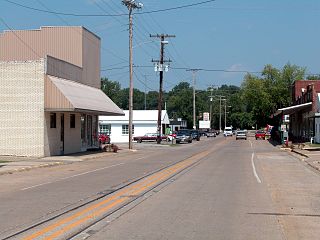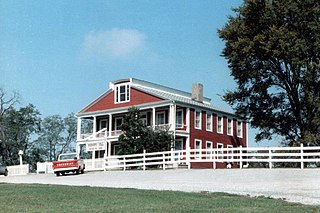
Hardin County is a county located in the U.S. state of Illinois. According to the 2020 census, it has a population of 3,649, making it the least populous county in Illinois. Its county seat is Elizabethtown. Hardin County is located in the part of the state known as Little Egypt. Hardin County was named for Hardin County, Kentucky, which was named in honor of Colonel John Hardin, an officer in the American Revolutionary War and the Northwest Indian War.

Gallatin County is a county located in the U.S. state of Illinois. According to the 2020 census, it has a population of 4,946, making it the third-least populous county in Illinois. Its county seat is Shawneetown. It is located in the southern portion of Illinois known locally as Little Egypt. Located at the mouth of the Wabash River, Gallatin County, along with neighboring Posey County, Indiana, and Union County, Kentucky form the tri-point of the Illinois-Indiana-Kentucky Tri-State Area.

Cave-In-Rock is a village in Hardin County, Illinois, United States. Its principal feature and tourist attraction is nearby Cave-In-Rock, on the banks of the Ohio River. In 1816, the earliest known permanent white settlers arrived and started building a town near the cave. The town was originally known as Rock and Cave, Illinois, with a post office under this name. On October 24, 1849, the town was officially renamed Cave-In-Rock. Cave-In-Rock was incorporated as a village in 1901. The population was 318 at the 2010 census.

Rosiclare is a city in Hardin County, Illinois, along the Ohio River. The population was 1,160 at the 2010 census, down from 1,213 at the 2000 census.

New Athens is a village in St. Clair County, Illinois, United States. Based upon common usage, the 'A' is always sounded with a long vowel, rather than a short vowel, by its residents, unlike the most commonly used English pronunciation of the city in Greece.
John Hardin was an American soldier, scout, and frontiersman. As a young man, he fought in Lord Dunmore's War, in which he was wounded, and gained a reputation as a marksman and "Indian killer." He served in the Continental Army during the American Revolutionary War, where he played a noteworthy role in the American victory at Saratoga in 1777. After the war, he moved to Kentucky, where he fought against Native Americans in the Northwest Indian War. In 1790, he led a detachment of Kentucky militia in a disastrous defeat known as "Hardin's Defeat." In 1792, he was killed while serving as an emissary to the Natives in the Northwest Territory.

James Ford, born James N. Ford, also known as James N. Ford, Sr., the "N" possibly for Neal, was an American civic leader and business owner in western Kentucky and southern Illinois, from the late 1790s to mid-1830s. Despite his clean public image as a "Pillar of the Community", Ford was secretly a river pirate and the leader of a gang that was later known as the "Ford's Ferry Gang". His men were the river equivalent of highway robbers. They hijacked flatboats and Ford's "own river ferry" for tradable goods from local farms that were coming down the Ohio River.

Micajah "Big" Harpe, born Joshua Harper, and Wiley "Little" Harpe, born William Harper, were murderers, highwaymen and river pirates who operated in Tennessee, Kentucky, Illinois and Mississippi in the late 18th century. They are often considered the earliest documented serial killers in the United States history.
The Shelton Brothers Gang was an early Prohibition-era bootlegging gang based in southern Illinois. They were the main rivals of the famous bootlegger Charles Birger and his gang. In 1950, the Saturday Evening Post described the Sheltons as "America's Bloodiest Gang". Ancestors of the Shelton Brothers Gang trace their roots back to Ireland, under the surname "Hunter". There are still some descendants living in the St. Louis, Fairfield, IL and Bloomington IL area today.

The Crenshaw House is an historic former residence and alleged haunted house located in Equality Township, Gallatin County, Illinois. The house was constructed in the 1830s. It was the main residence of John Crenshaw, his wife, and their five children.

John Hart Crenshaw was an American landowner, salt maker, kidnapper and slave trader, based out of Gallatin County, Illinois.

The Reverse Underground Railroad is the name given, sardonically, to the pre-American Civil War practice of kidnapping in free states not only fugitive slaves but free blacks as well, transporting them to slave states, and selling them as slaves, or occasionally getting a reward for return of a fugitive. Those who used the term were pro-slavery and angered at an "underground railroad" helping slaves escape. Also, the so-called "reverse underground railroad" had incidents but not a network, and its activities did not always take place in secret. Rescues of blacks being kidnapped were unusual.

Samuel Ross Mason, also spelled Meason, was a Virginia militia captain, on the American western frontier, during the American Revolutionary War. After the war, he became the leader of the Mason Gang, a criminal gang of river pirates and highwaymen on the lower Ohio River and the Mississippi River in the late 18th and early 19th centuries. He was associated with outlaws around Red Banks, Cave-in-Rock, Stack Island, and the Natchez Trace.

John Duff, born John McElduff, or John Michael McElduff, because early court records referred to him as John Michael Duff, was a counterfeiter, criminal gang leader, horse thief, cattle thief, hog thief, salt maker, longhunter, scout, and soldier who assisted in George Rogers Clark's campaign to capture the Illinois country for the American rebel side during the Revolutionary War.
Philip Alston was an 18th-century Spanish-American counterfeiter, both before and after the American Revolution. He operated in Virginia and the Carolinas before the war, and in Kentucky and Illinois afterward. He was associated with Cave-in-Rock and his son, outlaw Peter Alston, and counterfeiter John Duff. He was an early American settler in Natchez, as well as in the Cumberland and Red River valleys in Kentucky and Tennessee.

The Iron Mistress is a 1952 American Western film directed by Gordon Douglas and starring Alan Ladd and Virginia Mayo. It ends with Bowie's marriage to Ursula de Veramendi and does not deal with his death at the Battle of the Alamo in 1836.
Isaiah Luna Potts was infamous in legend and lore for having run a 19th-century Illinois tavern known as "Potts Inn" where numerous crimes including robbery and murder were committed.

Slavery in what became the U.S. state of Illinois existed for more than a century. Illinois did not become a state until 1818, but earlier regional systems of government had already established slavery. France introduced African slavery to the Illinois Country in the early eighteenth century. French and other inhabitants of Illinois continued the practice of owning slaves throughout the Illinois Country's period of British rule (1763-1783), as well as after its transfer to the new United States in 1783 as Illinois County, Virginia. The Northwest Ordinance (1787) banned slavery in Illinois and the rest of the Northwest Territory. Nonetheless, slavery remained a contentious issue, through the period when Illinois was part of the Indiana Territory and the Illinois Territory and some slaves remained in bondage after statehood until their gradual emancipation by the Illinois Supreme Court. Thus the history of slavery in Illinois covers several sometimes overlapping periods: French ; British ; Virginia ; United States Northwest Territory (1787-1800), Indiana Territory (1800-1809), Illinois Territory (1809-1818) and the State of Illinois.

The Illinois Salines, also known as the Saline Springs or Great Salt Springs, is a salt spring site located along the Saline River in Gallatin County, Illinois. The site was a source of salt for Illinois' prehistoric settlers and is now an archaeological site with a large quantity of organic remains. After European settlement of Illinois, the salt springs became part of Illinois' first major industry and were one of the only places in Illinois where slavery was legal after 1818.
























